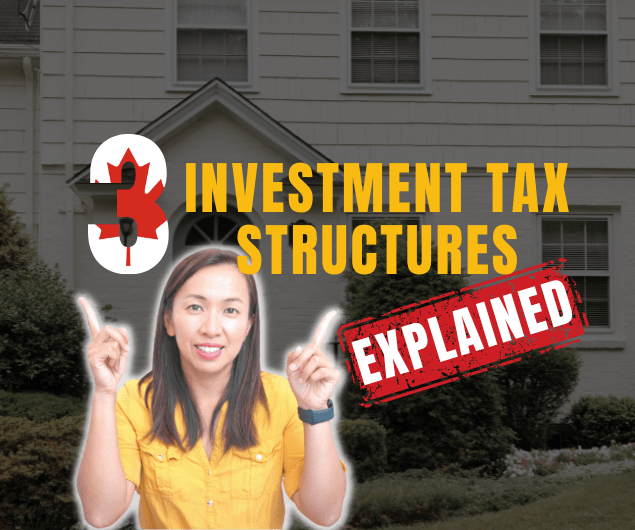Many of my clients invest with investment partners these days. Some of them are passive partners, providing funds to fund the investment, while others are active investors, doing everything else in the business venture.
There’re three common business models an investor can follow when it comes down to investing with an investment partner.
1. Joint ventures
According to Thomson Reuters Practical Law, “joint venture has no legal meaning in Canada. It represents a business model that multiple parties pool resources and share expertise for the purposes of a common venture.”
In real estate investment world, joint ventures are often formed by multiple parties with the objective of investing in properties.
Flexibility of structuring
From a tax perspective, joint venture provides a lot of tax benefits. It allows the participating investors to select the type of ownership that they prefer.
For example, two real estate investors are interested in investing a legal duplex in Hamilton.
One is a doctor who’s extremely busy with her day-to-day schedule. She intends to use her corporate structure to invest.
Another one is a real estate expert who just quits his job. Given his circumstances, his accountant advises him to invest in his personal name.
Her corporation can form a joint venture with his personal name to invest in the legal duplex in Hamilton.
A corporation and a person can form a joint venture to invest in properties.
A real estate investor can form a joint venture with another investor personally.
3 parties can also form joint venture together.
The possibility is endless.
Flow through nature
Each joint venture part is responsible for reporting his/her share of income, expenses, assets and liabilities of the joint venture.
If you invest in the joint venture using a corporation, this may include reporting your proportional assets and liabilities and share and expenses on the corporation.
If you have multiple joint venture investments, reporting of these joint ventures can be quite complicated and record keeping can be quite challenging.
One of the biggest benefits of joint venture business model is that each joint venture is allowed to deduct depreciation, also known as capital cost allowance, based on his/her own situation.
If these partners were to invest in the form of corporation or partnership, capital cost allowance is restricted at the corporation/partnership level.
Joint venture agreement
I can’t stress how important it is to have a proper joint venture agreement drafted and signed.
It specifies the roles and responsibilities of each investment partners, how you divide up the day-to-day profit, funds from refinancing and at sale, the investment horizon, conflict resolution, etc.
It even talks about what would happen if one partner passes away to protect the estate.
Make sure you speak to a real estate lawyer to draft up a proper joint venture agreement.
Just because you invest with a friend or family member whom you trust, it does not mean that there’re no issues down the road.
2. Corporation
Corporation is another commonly used structure that investors use to invest together.
Each investor owns shares of the corporation, which in turns own properties.
The biggest benefit of investing with your partners via corporation is the legal liability protection.
Corporation is considered a separate legal entity. It can sue and be sued on its own.
Generally speaking, you can have legal liability protection against your personal asset if, in the unfortunate event that your corporation is sued by a patron or a tenant.
This is the major difference between Joint Venture business model vs. corporation.
If you were to invest using JV model, exposure to liability also “flow through” to the JV investment partners. You might be exposing either all of your personal assets or corporate assets to this joint venture investment.
Ease of record keeping
Another benefit of investing through a corporate structure is the ease of record keeping.
Since the property is 100% owned by the corporation, 100% of the income & expenses, assets and liabilities are reported within the same entity, avoiding any complex proportional interest calculation.
Losses and depreciation are kept at the corporation level – no flow through
From my experience, most long-term rental real estate venture does not generate much profit in the first year. Often, we see losses in the first couple of years of stabilization.
Losses incurred from the operation of the real estate rental are staying at the corporation level.
Similarly, the depreciation, also known as Capital Cost Allowance, is claimed at the corporation level.
Had you set up a joint venture, you would have been able to utilize your proportional share of losses incurred during the stabilization period as well as the capital cost allowance to offset against income from other properties.
With corporation, that’s just not possible.
Shareholder agreement
With a corporation, a detailed shareholder agreement must be signed. Each shareholder should seek independent legal advice from their respective lawyer.
Similar to a joint venture agreement, a shareholder agreement should detail the responsibilities and expectation of each investment party. Some maybe more passive than others. An experienced lawyer should be able to help you draft out a proper shareholder agreement.
As mentioned earlier, a shareholder agreement should also have information on the expected investment horizon, steps on how to resolve conflicts, and what to do when one of the investment partners decide to sell his/her investment interest earlier.
3. Limited Partnership investment
Limited partnership is a form of general partnership – which is a business established by two or more partners.
Typically, it is operated with a single general partner with unlimited liability, supported by other “limited partners”, as per BDC.ca. In exchange for taking all the risk, the general partner is often rewarded with higher share of income and gain.
The limited partners contribute to the capital, but they are not involved in the day to day management of the business.
The liability of these limited partners is restricted to the amount that they invested.
As you can see, this is quite a complex structure. Minimal cost to setup starts from $10K and up, depending on the complexity of your limited partnership.
Flow through entity
From a tax perspective, a partnership is required to file its own partnership return.
As mentioned above, capital cost allowance, commonly known as depreciation, is also claimed at the partnership level.
What it means is that if the property invested is not generating any net income, the partnership is not allowed to take any capital cost allowance to defer income taxes.
If the underlying property is generating net income, the partnership is only allowed to take capital cost allowance to reduce the net rental income from that particular property to zero.
Unlike a joint venture relationship, each individual investment partner does not have the freedom to claim more than what was determined at the partnership level.
Similar to joint venture business model, if the underlying property is generating a loss in the initial years of operation, the losses can be flowed through to each individual limited partner. Each investment partner can report its share of losses, offsetting against other income he/she may receive from other sources.
For investors who are investing as limited partners, the amount of losses that they can claim is limited to the at-risk amount, which is generally calculated as amount of capital invested plus the income allocated over the years.
For limited partners investors, you may have a deemed capital gain if your adjusted cost base of your investment is negative. For real estate limited partnership investments, this situation can arise when you refinance the underlying property multiple times and have repaid your initial capital investment.
The calculation of the At Risk Amount as well as negative Adjusted Cost Base (ACB) can be quite complex and thus the filing cost can be more expensive than a regular corporation.
Legal liability protection
As mentioned above, the biggest advantage with a limited partnership is the limited liability protection and the flow through nature of the income & expenses.
The general partner who is responsible for the day-to-day operation and management of the business absorbs all the risk.
Typically, real estate investor would setup a corporation to act as a general partner.
Limited partnership agreement
As always, as an investor of a limited partnership, you should read the agreement in detail to have your rights protected.
As a general partner, having a limited partnership agreement to set out all the rules and conflict resolution can prevent a lot of problems down the road.
Now that I have covered all three common structure that you invest with partners, what are the ones you are using?
Is it just a handshake deal?
As always, if you ever need help, we are here to help you to recommend you on the best structure based on your particular circumstance.
Until next time, happy Canadian Real Estate Investing.
Cherry Chan, CPA, CA
Your Real Estate Accountant
P.S. Erwin and I are hosting the most anticipated event for the year – also known as the Wealth Hacker Conference Saturday, Nov 12 this year. When we hosted this event in 2019, over 1,500 hardworking Canadians joined us learning all different types of wealth hacks. Find out more about the event at www.WealthHacker.ca





